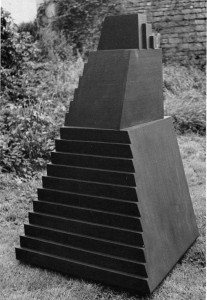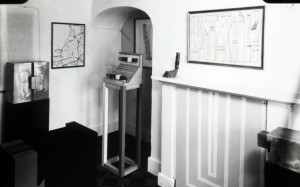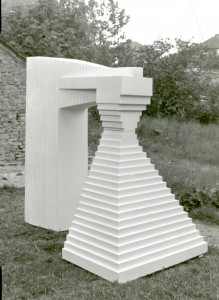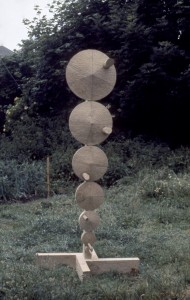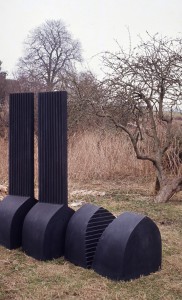In 1964, the house known as 8 Pound Pill comprised half of the whole building. At one time it was a small farmhouse, now it is set below the level of the road. This incline was modified by Brunel to accommodate a nearby railway bridge, across the line that was about to enter Box Tunnel. From the road there were seven steps going down to a path to the wide front door. Pound Pill was a building three stories high and mostly composed of little rooms with small windows and wooden shutters. The interior of the house was dark, the exception being the large square bedroom at the rear that overlooked fields and a small-holding. Looking out of that bedroom window and to the right, one could see the backs of the houses in Ludmead Road. The living room was tiny, I made it bigger by knocking down an interior wall and opening up the stone fireplace. The kitchen looked out onto the back garden. It had a low ceiling and in plan it was a curious diamond shape. On the right was another small room, an ‘office’ and there were stairs to the second floor. Up the stairs and then up again, stairs to the right and to the left, led into bedrooms. Firstly a single room, and then a very pleasant room that was always occupied by my two small children. Again upwards, via a twisting staircase, to reach the attic. This was the games room and more importantly and inconveniently, the bathroom and toilet, which had been newly installed for our occupation.
There was little comfort in this awkward cluster of rooms that were impossible to heat. We had few furnishings, only cheap fittings and fixtures, but nothing cheerful; most items had been bought from Thomas Best, the warehouse selling ex-MOD furnishings at Box. Even so it provided a good place for a young sculptor and his family to rattle around in, and for me to make sculpture.
The kitchen led to the back door and out into the garden, or straight on and up two steps into quite a large room adjoining the back of the house. Formerly with an earth floor, it had been given new concrete. Finally, down three steps to a cellar that ran the whole length of the house next door, where my extremely long-suffering neighbours Len and Chris lived. For twelve years they were the recipients of my studio noises and sometimes lethal chemical smells, (particularly from polyester resin which was very popular in the late sixties with sculptors but not, I suspect, with neighbours).
On the other side of the house was a stable with a cobbled floor and a wide half door with a window above it, as well as a side window. There was no ceiling, hence a high roof, perfect for a studio. At this distance I cannot understand why my priority at Pound Pill had not been to turn this space into a working space. Perhaps it was the general pervasive feeling of uncertainty and insecurity that inhibited any longish term investment in my living and working in Corsham, when at Bath Academy. True, I was put off by the sloping cobbled floor I suppose, but when I eventually dealt with this problem in the early seventies, it wasn’t such a great difficulty. With the help of students David Mann and Bob Fearns, I poured Ready Mix over the prepared hardcore, painted the walls white and moved in. I began working towards my show at Angela Flowers Gallery in 1976.
The heritage of that period in Pound Pill is not far away from me as I write this in Corsham Court. Two floors above B.38, my studio, in a suite of seminar and conference rooms, are exhibited several woodworks and drawings that were made in Pound Pill, a reminder of my Corsham years. They constitute an almost permanent retrospective.
At Pound Pill I was still working in clay. W hatever the final outcome I began my sculpture with clay. A friendly material and, up to a point, easy to handle and very reactive.
My response to the Aberfan disaster in October 1966 was Peep-O Arch, completely impractical as a ‘play’ sculpture, although prompted by the children’s game of ‘peep-o’. It was informed, as are many other of my sculpture and drawings, by the ziggurat or, more precisely, the step-pyramid. This is an image of aspiration: a celestial ladder. I made the arch in clay, using a large ruler and a spirit level on the sixty horizontal steps and thirty vertical steps. My way of working was a puzzle to a group of students from Cheltenham who were brought to Pound Pill on a studio visit by Ralph Brown, (formerly a tutor at the RCA). Why would anyone make such a work in clay when it would be more easily, and arguably, better made in wood?
I remember that making Peep-O Arch was a most intense period of working, long days and late nights, modelling the sculpture and keeping the clay damp to prevent drying and distortion. Making a mould, then a plaster cast and working the plaster until the whole was of refined clear forms without texture and few finger marks, avoiding a ‘felt’ surface. Optimistically I was aiming for anonymous manufacture. I recast the plaster via a piece-mould and filled it with a laminate of fibreglass and polyester resin. Out of a mould for the second time, the arch in two parts was sanded and filled and sanded again. Taking note of what David Smith had said about motor cars having innumerable coats of paint and so why not sculpture, I asked a local man to spray it white several times, until Peep-O Arch was pristine.
Jeannette Jackson of Camden Arts Centre curated Sculpture in the City for the Festival of London in 1968. Following the example of New York, where numerous sculpures were placed on sites throughout the City, (work made, in many cases, especially for the exhibition and for a particular place). The term ‘site specific’ was not yet common parlance. I had been asked to exhibit in Sculpture in the City and so the two parts of my Arch were fitted into the back of my old Standard Atlas van. I started early and drove from Corsham to London. My sculpture was enlarged by a nifty stepped plywood platform made especially for the show. Peep-O Arch was sited in a walk-through space at ground level between buildings – Lloyds Bank being one of them, I think. It could be well seen and I was extremely happy to be included in this prestigious exhibition, with sculptors more established and better known than me.
In my van I queued behind larger lorries with a Bryan Kneale, Anthony Caro, John Hoskin (all steel works) or a Wendy Taylor sculpture, on board, all waiting to be told by the Curator exactly where to off-load. Jeanette gave the other drivers instructions, a “Thank you” plus some pound notes. When my turn came I received a “Hello, Michael”, my instructions, a “Thank you” but no pound notes.
Having erected the work to my satisfaction, I pondered this missing gratuity, while I sat in a nearby pub eating a sandwich. I had very little money and felt that I deserved some recompense after having invested so much in this work. This occurrence was a hard lesson, I realised that recompense for a sculptor is hard to come by.
I didn’t photograph Peep-O Arch on that day, a big mistake. I had arranged a weekend visit to show my family the result of all that labour and expense.
Returning to London, again in the van, and turning the corner to come across Peep-O Arch sedate in the space and as a planned surprise, I was dumbstruck. My sculpture was black – well, dark grey – not pristine anymore! After only a few days of city dirt, the bright white surface had been obliterated. My sculpture had been deformed into a grime covered, sad looking object, almost indistiguishable from the grey concrete surrounding it. From the nearest office building I borrowed a bucket, some hot soapy water and a sponge and I washed my work clean again, but with a sinking heart, knowing full well that it would be battleship grey once more before too long. A miscalculation, making a sculpture with a surface that was inappropriate for that place. My participation in Sculpture in the City looked better on my CV than in reality.
But Peep-O Arch fared better at other places, especially in the gardens at Gregynog Hall in the middle of Wales, where it stood – looking good – for a year or so.
This episode at the Festival did affect subsequent sculptures. Peep-O Arch was followed by similarly cast works, Supremes, Bishop and Pyramid. They were all painted black!
“At some point on this bizarre continuum” I decided to recreate the studio that I had never occupied at the British School in Rome. Having a studio there was the major attraction of the scholarship in the first place. A space of my own to work in and sleep in – at that time a twenty-four hour studio appealed to me.
I had been using the stable next to the house at Pound Pill as a store. There was a sloping cobblestone floor that was impossible for making sculpture. The conversion from stable to studio took place on one cold November day in 1975. My two helpers and I covered the floor with Readymix. Bob and Dave spread the cement to make the floor level: a transformation! A surface that was smooth, perfect for standing sculptures on. Next job was to fill between the uneven stones that made up the walls, high enough but not all the way up, and paint them white more than once, until they were spotless. Then Bob Davis put in the cast-iron pot-bellied stove I’d been given by John Hoskin. Next job was the addition of a balcony, a wooden construction with handsome broad steps up to an area along the housewall of the studio, wide enough for a single bed. Finished off with a Belfast sink installed by Alan Price when he was staying over. Finally the studio was then completed with an added telephone.
A rectangle adjoining the house – the ideal studio. There were two windows, one above the door and the other in the side wall, and lots of daylight, especially with the half door open. It was an upgrade, an uncluttered space; the only furniture was an old woodwork bench with a vice. The balcony and the bed came in handy when, shortly after completion, I was banned from the house as an adulterer. But it was a cold place in December. Of course this perfect studio was a weapon in the armoury of my wife who was divorcing me. She did not believe that I would ever leave this place that I loved, for the other woman (that I also loved) – but I did.
My first wife was Catholic. I took the appropriate six pre-cana lessons before our marriage and agreed to raise the children in her religion. With my usual mixture of innocence and arrogance I thought I was well prepared to cope with our conflicting beliefs and dissimilar educations. Nuns in a local secondary school had taught my wife, I was from a notable Grammar school where some teachers were either sadists or pedophiles. But six lessons were not enough. Although my conversations with an intelligent Jesuit were illuminating.
As the years passed the marriage ties loosened. Our children were the glue keeping us together, but even that adhesive proved to be a fragile bond. Alison’s Down Syndrome and subsequent death were the hammer blows to our togetherness, and provided both of us with grounds for mistrust and blame, thoughts and feelings that were always just beneath the surface. They inevitably led to an irreparable split.
In the early seventies I was, as ever, self-absorbed, and interested primarily in making my way, climbing the ladder and playing the game, as they say. Most of my time and a big chunk of my earnings went on work, although I did spend lots of time with my children. Teaching only two or three days a week for thirty-six weeks a year gave me ample hours to make sculpture. That left plenty of the day and early evening for play, especially in the garden. I repeatedly mowed the grass to make it flat, although gently sloping down to the nut trees that hid the little stream which was our boundary. Netball, football, croquet, cricket, clock golf, boules, kite flying and cycling were our outdoor sports. Around Christmas time, upstairs on the second storey in an attic room that stretched the length of the house, we built a very long and complicated model car-racing track and we also played the best game ever, miniature ice hockey. I enjoyed these ‘sports’ with my children enormously, as I usually won all the contests, until the day when the alertness and quicker reactions of younger minds with more dextrous fingers got the better of me, and I was never to win again.
